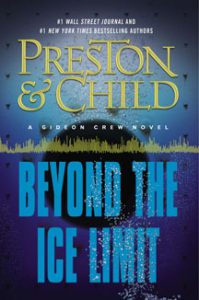After receiving “many thousands” of letters and emails asking for a sequel to “The Ice Limit” (2000) (as they recount in an author’s note), Douglas Preston and Lincoln Child finally go “Beyond the Ice Limit” (May 2016, hardcover; now in paperback). As those readers sensed, and as the authors realize in this 374-page novel, there is more story to tell – and it’s a good one that stirs up a lot of sci-fi thoughts and ideas.
Not a groundbreaking novel (“The Abyss,” “Sphere,” “2001,” “Alien,” “Virus” and “Independence Day: Resurgence” all came to mind as various themes and concepts popped up), “Beyond the Ice Limit” is still an expertly crafted thriller that mixes various old ideas in a way that doesn’t feel like a lazy rip-off. Somehow the authors put the fate of the world at stake and have a giant ocean vessel descend into chaos without the story becoming overblown or hard to follow.
The main character is somewhat reluctant adventurer Gideon Crew, who is coming off the excellent “The Lost Island.” But Eli Glinn, his billionaire handler of sorts who appeared in the three previous Crew novels plus the original “Ice Limit,” is the most interesting character. His arrogance led to the deaths of more than 100 people on that first mission to load and transport a massive meteorite from the tip of South America. Now that same arrogance is the driving force for an unselfish endeavor: to save humanity. Like John Hammond in the “Jurassic Park” series, his personality hasn’t changed even if his goals have become less self-centered: He still uses people to achieve his ends.
Set five years after “The Ice Limit,” “Beyond” is set in the present day. Crew members watching “Game of Thrones” on the massive ship’s multiple-month journey from New York to the Antarctic Ice Limit – where the icebergs calve during the spring (November in the Southern Hemisphere) – attest to this, meaning that the original novel was set in about 2011. I haven’t re-read it to see if that timeline holds up. (However, take heart that it’s not necessary to re-read “The Ice Limit” in order to understand what’s happening in this book. The authors provide plenty of flashbacks to refresh our memories and perhaps even clarify what happened. I remember liking “The Ice Limit,” but also being confused about the events in the final act.)
Now knowing that the meteorite is an alien entity, Glinn aims to study it and, if necessary, destroy it before it can wipe out humanity. While Preston and Child for a long time felt the revelation of the meteorite’s nature was a tidy ending to “The Ice Limit” (there was “only one possible outcome” after the final page, they thought) the sequel shows this concept is worth digging into further. Unfortunately, they only scratch the surface of the most interesting element: The tree-like entity on the ocean floor – which a crew member dubs “the Baobab” – is a parasite that absorbs brains to become its own brains.

When a character becomes a victim of the Baobab, Gideon and meteorite hunter McFarlane – who returns from “The Ice Limit” (as does that OTHER eccentric billionaire, Palmer Lloyd) – briefly reflect on the existential horror of being a disembodied brain. But we never get the victim’s perspective. The Bib Fortuna arc in “Star Wars: Tales from Jabba’s Palace” and the “X-Wing” comics – where he becomes disembodied by the b’omarr monks – remains among the best writing on this bizarre concept.
Preston and Child deliver some engaging characters. Naturally – as he is somewhat of a James Bond update – Gideon hits it off with submarine chief Alex, who of course is “about 35 and stunningly attractive, with a heart-shaped face and agate-colored eyes.” The most entertaining character is tech expert Prothero, a smarter and more abrasive version of Nedry from “Jurassic Park.” Using his library of blue whale sounds, he’s able to decipher the Baobab’s communications. This provides a tense thrill similar to the alien-message translation scenes in “Event Horizon,” last year’s “Arrival” and other sci-fi works.
However, it doesn’t ultimately add anything to the genre of “What is alien life like?,” just as the disembodied brain idea only scratches the surface. And “Beyond” includes other moments that hint at intriguing questions only to be quickly solved or shelved. For example, the brain of the victim briefly seems to be communicating with Gideon; is it just an echo, like the deadly plants in “The Ruins,” or is it a true communication? The alien entity might be a machine, or it might be a silicon-based lifeform, like in the “X-Files” episode “Firewalker.” What is the line between organic and machine? The Baobab’s main brain is an alien victim from far away. What’s its story? Preston and Child, in keeping with the concept of the Crew novels, write a thriller rather than a sci-fi think piece.
Because the action and some emotional scenes (Glinn finding his former lover’s corpse, for example) are so well-written, I can’t dismiss “Beyond the Ice Limit.” It’s a worthy sequel to “The Ice Limit,” which I’ll have to re-read at some point. But I am slightly disappointed that Preston and Child don’t go as deep as they could have into these classic sci-fi themes. Maybe that’s unfair; after all, if they weren’t inspired to explore these threads further, forcing themselves to do so wouldn’t necessarily lead to a better novel. Maybe it’s a case where they need another 16 years and another thousand emails to stew over what they’ve created, and we’ll eventually get an “Ice Limit 3.”

